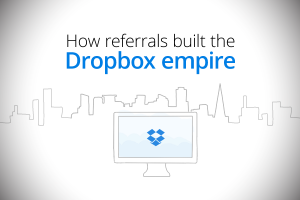Referral Candy: How Referrals Built the Dropbox Empire
Referral Candy recently published a story on their blog entitled, “How Referrals Built the Dropbox Empire” detailing the incredible results Dropbox has experienced through the awesome power of referrals. This is a must read for marketers.
In its latest round of fundraising, Dropbox raised between $250 to $400 million dollars, which put the company at a valuation of ten billion dollars. That’s $10,000,000,000! That makes it worth just slightly less than Pinterest + Snapchat + Uber combined. (Very value. Much fundraising. Wow.)
Dropbox: The Gold Standard for Referrals
 There’s a lot to study about Dropbox’s success, but let’s focus on something we find particularly telling: Dropbox is often cited as the canonical example of a dual-sided-incentive referral program.
There’s a lot to study about Dropbox’s success, but let’s focus on something we find particularly telling: Dropbox is often cited as the canonical example of a dual-sided-incentive referral program.
Just as Shakespeare imitated his predecessors, Dropbox wasn’t actually being original with its referral program- but they did it so well that that it would become what all other referral programs now aspire to.
According to founder/CEO Drew Houston, referrals increased signups by SIXTY percent, PERMANENTLY. They went from 100,000 to 4,000,000 users in 15 months. That’s a 40x increase, or a doubling of users every 3 months In April 2010, Dropbox users sent 2.8 million direct referral invites! It’s hard to imagine putting that sort of high quality reach into monetary terms. It would look like, I don’t know… ten billion dollars? :p
Acquisition through AdWords would’ve cost them $233-$388 per customer for a $99 product. If that were their only means of customer acquisition, the business would’ve failed. Not only did referrals allow Dropbox to escape death, it allowed them to avoid all traditional ad spend. That in turn which would have allowed them to focus their resources on making a better product- further cementing their competitive advantage.
According to Drew, the incentive program was inspired by PayPal (which we will get to in our next blogpost!). While PayPal rewarded its users with cash, Dropbox gave extra storage space to both the referrer and the referees. This was clever, because it invests the users in the product. It made sense for PayPal to give cash, because they’re a payments company and need users to use their service to make financial transactions. Dropbox is a storage company, and they need their users to use their service to store stuff.
In both cases, the optimal currency is the lifeblood of the product. In World of Warcraft, the reward is in-game social currency, in the form of rare Mounts that can be shown off. And in all cases, not only do referrals introduce new users to the product, they facilitate conversation which strengthens the brand. A referral is a way of talking about a brand AND a valid excuse to talk about it more.
The Finer Details of Dropbox’s Referral Program:
- Bake it in! The referral process was built right into the setup/onboarding process. The signup was 6 steps, the last being “Invite some friends to join Dropbox”
- Sell the sizzle, not the steak. It wasn’t positioned as “Invite friends” but “Get more free space”.
- Make it easy for your customers to help you help them. Multiple ways to easily share: Via email, email address book importing, post link to Facebook, Twitter.
- First things first. The Social sharing was prioritized as the first option (above email in the UI).
- Everybody’s a sucker for progress bars. User dashboard allowed users track the status of their referrals, which makes it fun rather than tedious.
- Did you mean recursion? Email confirmation of new free space when successful referrals were made had a call to invite more friends in the email. Keep the viral loop going strong!
- Appeal to influencers. Power users loved publishing their invites to their online followers- it made them look benevolent and cool. Always have a clear answer to “What’s in it for ME?”
Referrals don’t invent demand, they amplify it.
It’s important to realize that the most important element of Dropbox’s success is that it works really well. In CEO Drew Houston’s words, ”Building a bulletproof, scalable, cross-platform cloud storage architecture is hard.” Dropbox eliminated all the unnecessary complications and clutter and focused on delivering its core competency really, really well.
Once you’ve got that, we bet that you too could hack your growth by leveraging the awesome, underestimated power of referral programs.
